Zijia Zhao
Kimi-VL Technical Report
Apr 10, 2025Abstract:We present Kimi-VL, an efficient open-source Mixture-of-Experts (MoE) vision-language model (VLM) that offers advanced multimodal reasoning, long-context understanding, and strong agent capabilities - all while activating only 2.8B parameters in its language decoder (Kimi-VL-A3B). Kimi-VL demonstrates strong performance across challenging domains: as a general-purpose VLM, Kimi-VL excels in multi-turn agent tasks (e.g., OSWorld), matching flagship models. Furthermore, it exhibits remarkable capabilities across diverse challenging vision language tasks, including college-level image and video comprehension, OCR, mathematical reasoning, and multi-image understanding. In comparative evaluations, it effectively competes with cutting-edge efficient VLMs such as GPT-4o-mini, Qwen2.5-VL-7B, and Gemma-3-12B-IT, while surpassing GPT-4o in several key domains. Kimi-VL also advances in processing long contexts and perceiving clearly. With a 128K extended context window, Kimi-VL can process diverse long inputs, achieving impressive scores of 64.5 on LongVideoBench and 35.1 on MMLongBench-Doc. Its native-resolution vision encoder, MoonViT, further allows it to see and understand ultra-high-resolution visual inputs, achieving 83.2 on InfoVQA and 34.5 on ScreenSpot-Pro, while maintaining lower computational cost for common tasks. Building upon Kimi-VL, we introduce an advanced long-thinking variant: Kimi-VL-Thinking. Developed through long chain-of-thought (CoT) supervised fine-tuning (SFT) and reinforcement learning (RL), this model exhibits strong long-horizon reasoning capabilities. It achieves scores of 61.7 on MMMU, 36.8 on MathVision, and 71.3 on MathVista while maintaining the compact 2.8B activated LLM parameters, setting a new standard for efficient multimodal thinking models. Code and models are publicly accessible at https://github.com/MoonshotAI/Kimi-VL.
Image Difference Grounding with Natural Language
Apr 02, 2025Abstract:Visual grounding (VG) typically focuses on locating regions of interest within an image using natural language, and most existing VG methods are limited to single-image interpretations. This limits their applicability in real-world scenarios like automatic surveillance, where detecting subtle but meaningful visual differences across multiple images is crucial. Besides, previous work on image difference understanding (IDU) has either focused on detecting all change regions without cross-modal text guidance, or on providing coarse-grained descriptions of differences. Therefore, to push towards finer-grained vision-language perception, we propose Image Difference Grounding (IDG), a task designed to precisely localize visual differences based on user instructions. We introduce DiffGround, a large-scale and high-quality dataset for IDG, containing image pairs with diverse visual variations along with instructions querying fine-grained differences. Besides, we present a baseline model for IDG, DiffTracker, which effectively integrates feature differential enhancement and common suppression to precisely locate differences. Experiments on the DiffGround dataset highlight the importance of our IDG dataset in enabling finer-grained IDU. To foster future research, both DiffGround data and DiffTracker model will be publicly released.
Efficient Motion-Aware Video MLLM
Mar 17, 2025Abstract:Most current video MLLMs rely on uniform frame sampling and image-level encoders, resulting in inefficient data processing and limited motion awareness. To address these challenges, we introduce EMA, an Efficient Motion-Aware video MLLM that utilizes compressed video structures as inputs. We propose a motion-aware GOP (Group of Pictures) encoder that fuses spatial and motion information within a GOP unit in the compressed video stream, generating compact, informative visual tokens. By integrating fewer but denser RGB frames with more but sparser motion vectors in this native slow-fast input architecture, our approach reduces redundancy and enhances motion representation. Additionally, we introduce MotionBench, a benchmark for evaluating motion understanding across four motion types: linear, curved, rotational, and contact-based. Experimental results show that EMA achieves state-of-the-art performance on both MotionBench and popular video question answering benchmarks, while reducing inference costs. Moreover, EMA demonstrates strong scalability, as evidenced by its competitive performance on long video understanding benchmarks.
ChatSearch: a Dataset and a Generative Retrieval Model for General Conversational Image Retrieval
Oct 24, 2024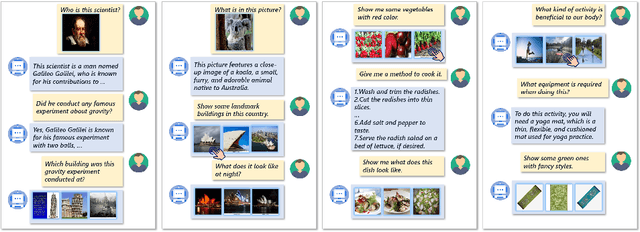
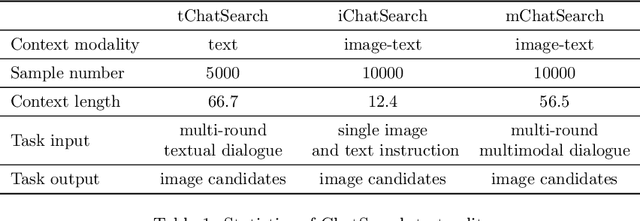
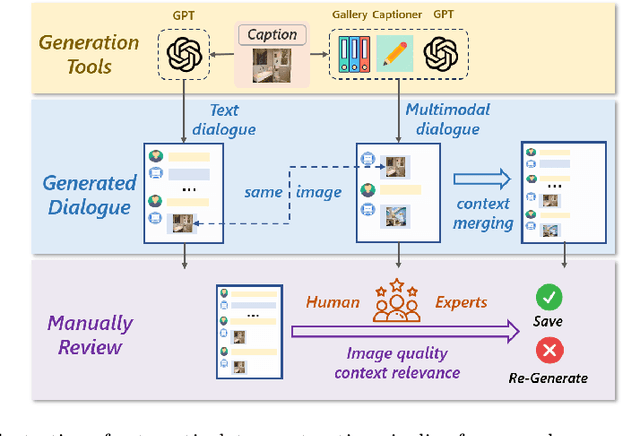

Abstract:In this paper, we investigate the task of general conversational image retrieval on open-domain images. The objective is to search for images based on interactive conversations between humans and computers. To advance this task, we curate a dataset called ChatSearch. This dataset includes a multi-round multimodal conversational context query for each target image, thereby requiring the retrieval system to find the accurate image from database. Simultaneously, we propose a generative retrieval model named ChatSearcher, which is trained end-to-end to accept/produce interleaved image-text inputs/outputs. ChatSearcher exhibits strong capability in reasoning with multimodal context and can leverage world knowledge to yield visual retrieval results. It demonstrates superior performance on the ChatSearch dataset and also achieves competitive results on other image retrieval tasks and visual conversation tasks. We anticipate that this work will inspire further research on interactive multimodal retrieval systems. Our dataset will be available at https://github.com/joez17/ChatSearch.
Beyond Filtering: Adaptive Image-Text Quality Enhancement for MLLM Pretraining
Oct 21, 2024



Abstract:Multimodal large language models (MLLMs) have made significant strides by integrating visual and textual modalities. A critical factor in training MLLMs is the quality of image-text pairs within multimodal pretraining datasets. However, $\textit {de facto}$ filter-based data quality enhancement paradigms often discard a substantial portion of high-quality image data due to inadequate semantic alignment between images and texts, leading to inefficiencies in data utilization and scalability. In this paper, we propose the Adaptive Image-Text Quality Enhancer (AITQE), a model that dynamically assesses and enhances the quality of image-text pairs. AITQE employs a text rewriting mechanism for low-quality pairs and incorporates a negative sample learning strategy to improve evaluative capabilities by integrating deliberately selected low-quality samples during training. Unlike prior approaches that significantly alter text distributions, our method minimally adjusts text to preserve data volume while enhancing quality. Experimental results demonstrate that AITQE surpasses existing methods on various benchmark, effectively leveraging raw data and scaling efficiently with increasing data volumes. We hope our work will inspire future works. The code and model are available at: https://github.com/hanhuang22/AITQE.
Exploring the Design Space of Visual Context Representation in Video MLLMs
Oct 17, 2024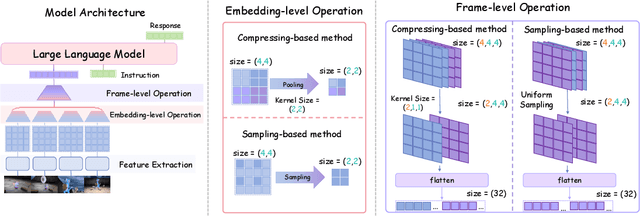



Abstract:Video Multimodal Large Language Models (MLLMs) have shown remarkable capability of understanding the video semantics on various downstream tasks. Despite the advancements, there is still a lack of systematic research on visual context representation, which refers to the scheme to select frames from a video and further select the tokens from a frame. In this paper, we explore the design space for visual context representation, and aim to improve the performance of video MLLMs by finding more effective representation schemes. Firstly, we formulate the task of visual context representation as a constrained optimization problem, and model the language modeling loss as a function of the number of frames and the number of embeddings (or tokens) per frame, given the maximum visual context window size. Then, we explore the scaling effects in frame selection and token selection respectively, and fit the corresponding function curve by conducting extensive empirical experiments. We examine the effectiveness of typical selection strategies and present empirical findings to determine the two factors. Furthermore, we study the joint effect of frame selection and token selection, and derive the optimal formula for determining the two factors. We demonstrate that the derived optimal settings show alignment with the best-performed results of empirical experiments. Our code and model are available at: https://github.com/RUCAIBox/Opt-Visor.
OneDiff: A Generalist Model for Image Difference
Jul 08, 2024



Abstract:In computer vision, Image Difference Captioning (IDC) is crucial for accurately describing variations between closely related images. Traditional IDC methods often rely on specialist models, which restrict their applicability across varied contexts. This paper introduces the OneDiff model, a novel generalist approach that utilizes a robust vision-language model architecture, integrating a siamese image encoder with a Visual Delta Module. This innovative configuration allows for the precise detection and articulation of fine-grained differences between image pairs. OneDiff is trained through a dual-phase strategy, encompassing Coupled Sample Training and multi-task learning across a diverse array of data types, supported by our newly developed DiffCap Dataset. This dataset merges real-world and synthetic data, enhancing the training process and bolstering the model's robustness. Extensive testing on diverse IDC benchmarks, such as Spot-the-Diff, CLEVR-Change, and Birds-to-Words, shows that OneDiff consistently outperforms existing state-of-the-art models in accuracy and adaptability, achieving improvements of up to 85\% CIDEr points in average. By setting a new benchmark in IDC, OneDiff paves the way for more versatile and effective applications in detecting and describing visual differences. The code, models, and data will be made publicly available.
Towards Event-oriented Long Video Understanding
Jun 20, 2024Abstract:With the rapid development of video Multimodal Large Language Models (MLLMs), numerous benchmarks have been proposed to assess their video understanding capability. However, due to the lack of rich events in the videos, these datasets may suffer from the short-cut bias that the answers can be deduced from a few frames, without the need to watch the entire video. To address this issue, we introduce Event-Bench, an event-oriented long video understanding benchmark built on existing datasets and human annotations. Event-Bench includes six event-related tasks and 2,190 test instances to comprehensively evaluate video event understanding ability. Additionally, we propose Video Instruction Merging~(VIM), a cost-effective method that enhances video MLLMs using merged, event-intensive video instructions, addressing the scarcity of human-annotated, event-intensive data. Extensive experiments show that the best-performing model, GPT-4o, achieves an overall accuracy of 53.33, significantly outperforming the best open-source model by 41.42%. Leveraging an effective instruction synthesis method and an adaptive model architecture, VIM surpasses both state-of-the-art open-source models and GPT-4V on the Event-Bench. All code, data, and models are publicly available at https://github.com/RUCAIBox/Event-Bench.
Needle In A Video Haystack: A Scalable Synthetic Framework for Benchmarking Video MLLMs
Jun 13, 2024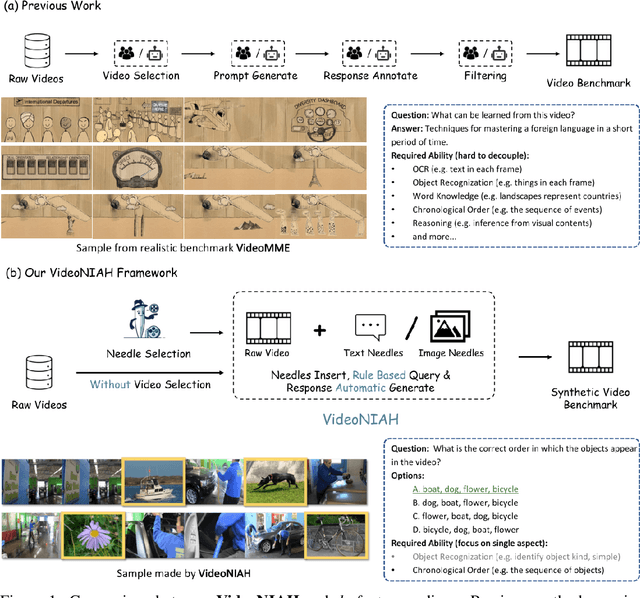
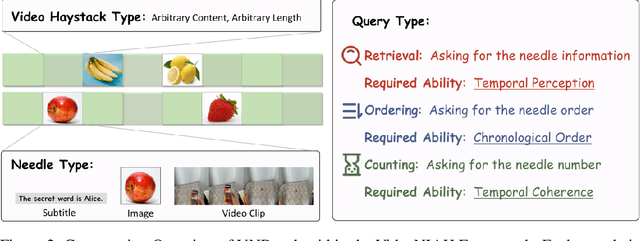


Abstract:Video understanding is a crucial next step for multimodal large language models (MLLMs). To probe specific aspects of video understanding ability, existing video benchmarks typically require careful video selection based on the target capability, along with laborious annotation of query-response pairs to match the specific video content. This process is both challenging and resource-intensive. In this paper, we propose VideoNIAH (Video Needle In A Haystack), a benchmark construction framework through synthetic video generation. VideoNIAH decouples test video content from their query-responses by inserting unrelated image/text 'needles' into original videos. It generates annotations solely from these needles, ensuring diversity in video sources and a variety of query-responses. Additionally, by inserting multiple needles, VideoNIAH rigorously evaluates the temporal understanding capabilities of models. We utilized VideoNIAH to compile a video benchmark VNBench, including tasks such as retrieval, ordering, and counting. VNBench can efficiently evaluate the fine-grained understanding ability and spatio-temporal modeling ability of a video model, while also supporting the long-context evaluation. Additionally, we evaluated recent video-centric multimodal large language models (MLLMs), both open-source and proprietary, providing a comprehensive analysis. We found that although proprietary models have significant advantages over open-source models, all existing video models still perform poorly on long-distance dependency tasks. VideoNIAH is a simple yet highly scalable benchmark construction framework, and we believe it will inspire future video benchmark works. The code and data are available at https://github.com/joez17/VideoNIAH.
SC-Tune: Unleashing Self-Consistent Referential Comprehension in Large Vision Language Models
Mar 20, 2024

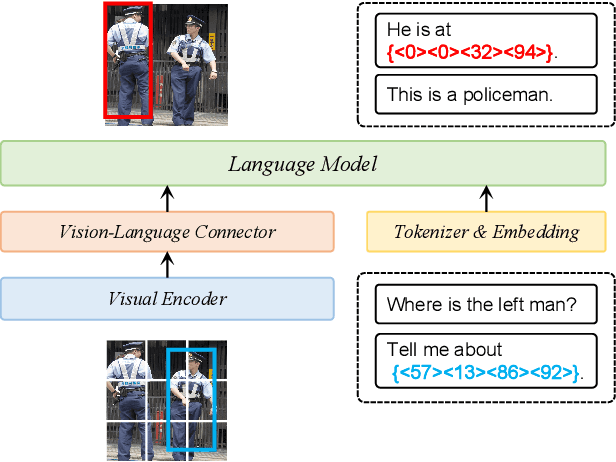

Abstract:Recent trends in Large Vision Language Models (LVLMs) research have been increasingly focusing on advancing beyond general image understanding towards more nuanced, object-level referential comprehension. In this paper, we present and delve into the self-consistency capability of LVLMs, a crucial aspect that reflects the models' ability to both generate informative captions for specific objects and subsequently utilize these captions to accurately re-identify the objects in a closed-loop process. This capability significantly mirrors the precision and reliability of fine-grained visual-language understanding. Our findings reveal that the self-consistency level of existing LVLMs falls short of expectations, posing limitations on their practical applicability and potential. To address this gap, we introduce a novel fine-tuning paradigm named Self-Consistency Tuning (SC-Tune). It features the synergistic learning of a cyclic describer-locator system. This paradigm is not only data-efficient but also exhibits generalizability across multiple LVLMs. Through extensive experiments, we demonstrate that SC-Tune significantly elevates performance across a spectrum of object-level vision-language benchmarks and maintains competitive or improved performance on image-level vision-language benchmarks. Both our model and code will be publicly available at https://github.com/ivattyue/SC-Tune.
 Add to Chrome
Add to Chrome Add to Firefox
Add to Firefox Add to Edge
Add to Edge